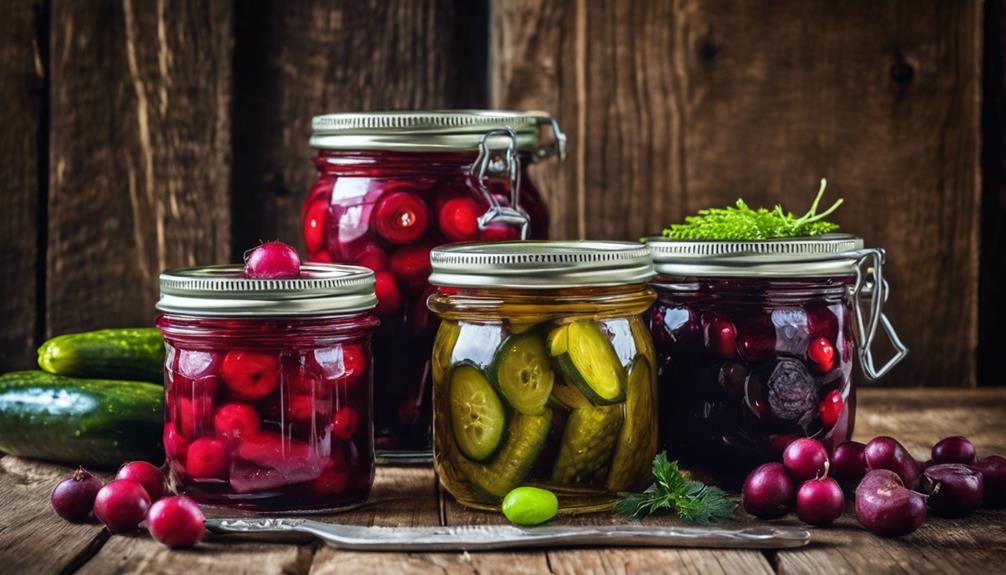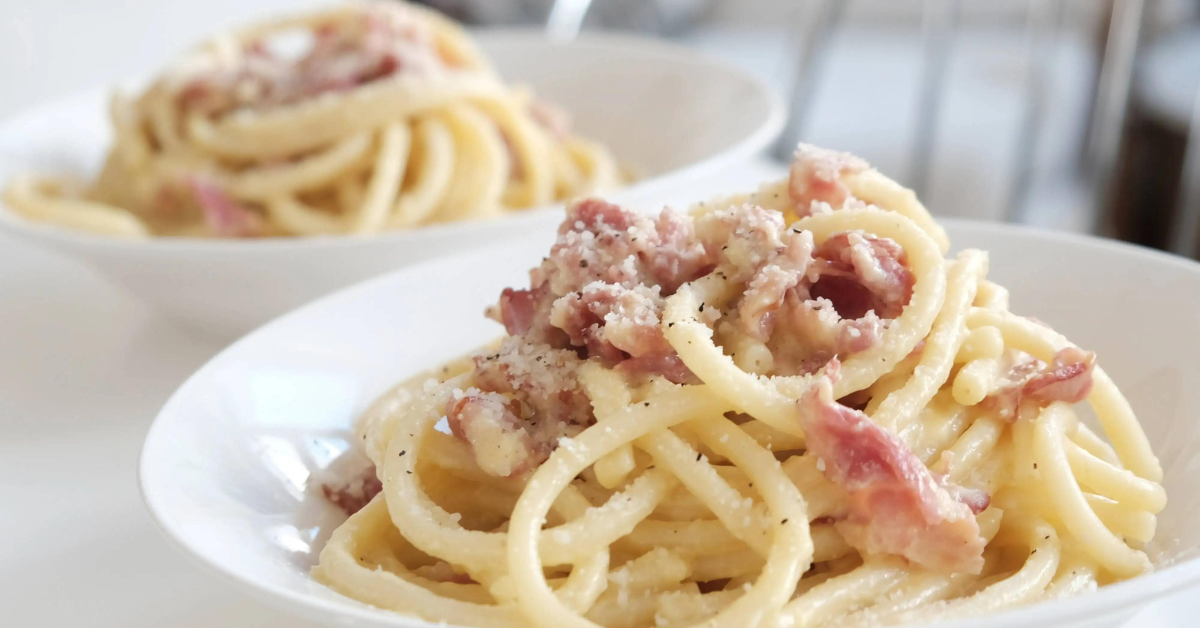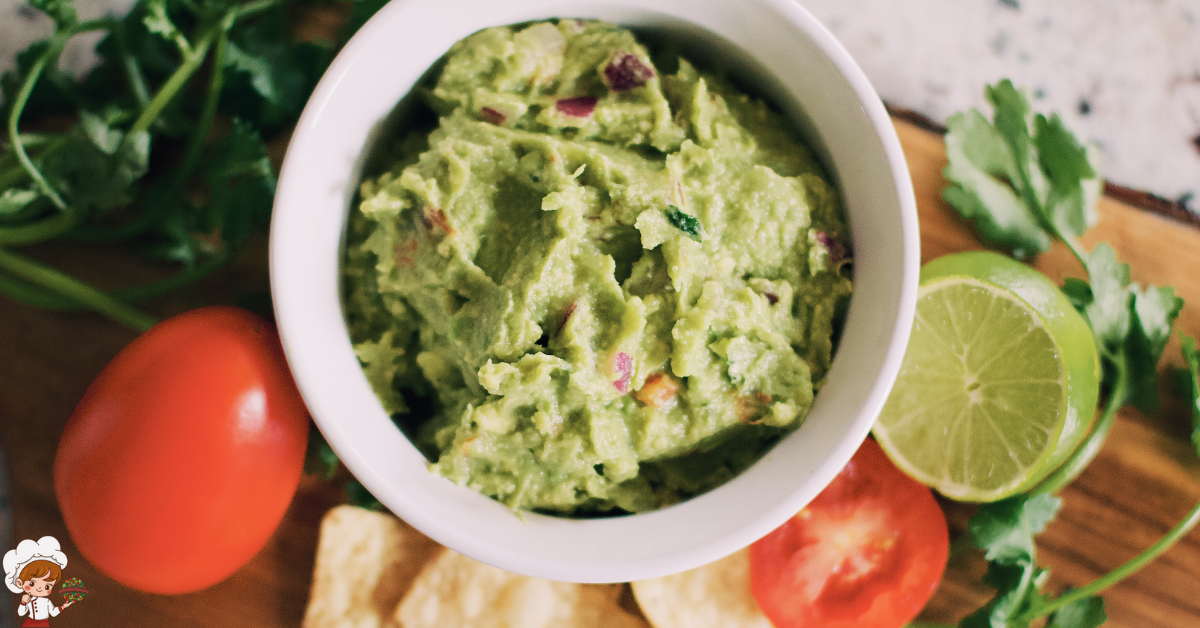What Are The Unique Flavors Of Swedish Pickled Foods

Unique Flavors Of Swedish Pickled Foods; Swedish pickled foods explode with unique flavors that perfectly blend sweetness and tanginess. You’ll find tangy herring varieties like sursill, marinated in sharp vinegar and mustard seeds, and senapssill, coated in creamy mustard sauce. Sweet-sour cucumber delights often incorporate dill and allspice for aromatic flair. Spicy pickled root vegetables combine carrots and radishes with bold ingredients like chili flakes and garlic. The use of sugar balances flavors, enhancing the overall taste. Each dish reflects Swedish culinary traditions and culture. If you’re curious about other fascinating aspects of these pickles, there’s much more to discover!
Overview of Swedish Pickling
Swedish pickling is a time-honored tradition that reflects the country’s agricultural heritage and resourcefulness. This practice dates back centuries, rooted deeply in Sweden’s pickling history. You’ll find that Swedish fermentation methods have evolved over time, adapting to the seasonal availability of ingredients. By preserving vegetables, fruits, and fish, Swedes utilized their harvests, ensuring food security during long winters.
As you explore this culinary art, you’ll notice that the pickling process often combines vinegar, sugar, and spices, creating a balance of sweet and sour flavors. Unlike other fermentation techniques, Swedish pickling typically emphasizes a quick process, allowing you to enjoy vibrant, fresh tastes without lengthy fermentation periods. This method has not only preserved food but also enhanced its flavors, making pickled items a staple in Swedish cuisine.
When you think of traditional Swedish dishes, pickled herring immediately comes to mind. It’s a prime example of how pickling has shaped the nation’s culinary identity. You’ll also find an array of pickled vegetables accompanying many meals, showcasing the diversity of Swedish flavors.
In Swedish culture, pickling isn’t just about preservation; it’s about celebrating seasonal ingredients and family traditions. Whether you’re savoring a festive smorgasbord or enjoying a simple meal, the unique flavors of Swedish pickled foods are sure to leave a lasting impression. As you immerse yourself in this fascinating world, you’ll appreciate how centuries of practice have shaped the vibrant tastes you enjoy today.
Key Ingredients in Pickling
What makes pickled foods so distinctive and flavorful? The answer lies in the key ingredients that transform ordinary vegetables and fish into tangy delights. At the heart of this process is the brine—a mixture of vinegar, water, and salt. The brine ratios are essential; a common combination is equal parts vinegar and water, with salt added to taste. This balance not only preserves the food but also enhances its flavor.
Next up are the pickling spices, which play an important role in shaping the final taste of your pickled creations. You’ll often find a blend of mustard seeds, coriander, dill, and allspice in Swedish pickling recipes. These spices infuse the brine with aromatic notes, giving your pickled foods a unique character. You can customize your spice mix based on your preferences, adding things like garlic, black peppercorns, or even a hint of sugar for sweetness.
The choice of vegetables or fish you use also impacts the overall flavor. Whether you’re pickling cucumbers, beets, or herring, each ingredient contributes its own essence, allowing for a delightful variety of tastes.
Tangy Herring Varieties
When it comes to tangy herring varieties, the options are as diverse as they are delicious. You’ll find that Swedish pickled herring showcases a range of herring types, each bringing its unique flavor profile to the table. One popular type is the “Sursill,” which is marinated in a sharp vinegar solution combined with spices like mustard seeds and black peppercorns. This method enhances the fish’s natural brininess while adding a zesty kick.
Another delightful option is “Senapssill,” where the herring is coated in a creamy mustard sauce. This recipe balances tanginess with sweetness, making it a favorite among those who enjoy a bit more complexity in their herring dishes. You might also encounter “Löksill,” featuring onions steeped in the marinade, which adds an aromatic element to the herring.
If you’re looking to experiment, try creating your own herring recipes. Start with fillets of pickled herring, and mix in your favorite spices or vegetables. Some people enjoy adding fresh dill or sliced apples for a revitalizing twist. You could even combine different herring types for a unique tasting experience.
Whether you’re enjoying these tangy herring varieties on crispbread or as part of a smorgasbord, you’ll appreciate how each herring recipe reflects Sweden’s culinary heritage. So, plunge into and savor the vibrant flavors that pickled herring has to offer—they’re sure to tantalize your taste buds!
Sweet-Sour Cucumber Delights
Crisp, vibrant cucumbers take center stage in the world of sweet-sour delights. These pickled gems showcase the magical balance of sweetness and tanginess that defines Swedish cuisine. You’ll find various cucumber varieties used in pickling, each bringing its own unique texture and flavor profile to the table. From the classic European cucumber to the smaller, crunchier gherkins, the choices are endless.
When you begin your pickling journey, the selection of pickling spices is key. Mustard seeds, dill, and allspice are popular choices that infuse the cucumbers with aromatic goodness. The sweet-sour brine, made from vinegar, sugar, and water, is where the real magic happens. This combination creates a delightful contrast, elevating the flavor of the cucumbers to new heights.
To create your own sweet-sour cucumber delights, start by slicing your chosen cucumber varieties and placing them in a jar. Next, prepare your brine by heating vinegar, sugar, and your favorite pickling spices until the sugar dissolves. Pour this mixture over the cucumbers, ensuring they’re fully submerged. Seal the jar and let the flavors meld in the fridge for at least 24 hours.
As you savor these sweet-sour cucumbers, you’ll appreciate how they complement traditional Swedish dishes, adding a revitalizing crunch to meals. Whether served alongside herring or enjoyed as a snack, sweet-sour cucumber delights are a quintessential part of Swedish pickled foods that you won’t want to miss.
Spicy Pickled Root Vegetables
Plunge into the vibrant world of spicy pickled root vegetables, where bold flavors intertwine to create a delightful culinary experience. You’ll find a root medley that typically includes carrots, beets, and radishes, each bringing its own unique texture and taste to the table. These vegetables are not just good for you; they also pack a spicy crunch that elevates any dish they accompany.
The process begins with selecting fresh, crisp root vegetables. Once you’ve got your medley, you can immerse them in a tangy brine infused with spices like chili flakes, mustard seeds, and garlic. As they pickle, the flavors meld together, creating a perfect balance of heat and acidity. This is where the magic happens—each bite bursts with a delightful zing that keeps your taste buds dancing.
Spicy pickled root vegetables are incredibly versatile. You can enjoy them as a zesty side dish, toss them into salads for an extra kick, or even use them as a topping for sandwiches and tacos. The crunchiness adds texture, while the spice awakens your palate, making every meal unforgettable.
Whether you’re a fan of heat or just looking to add something new to your culinary repertoire, spicy pickled root vegetables won’t disappoint. They embody the essence of Swedish pickling, offering a unique and exciting flavor profile that sets them apart from your everyday pickles.
Unique Preserving Techniques
When you think about Swedish pickled foods, it’s fascinating to explore the traditional methods that make them unique. You’ll discover how different ingredient combinations and regional variations create distinct flavors in each jar. Let’s take a closer look at these preserving techniques that bring out the best in every pickle.
Traditional Pickling Methods
Swedes have perfected unique preserving techniques that elevate their pickled foods to a culinary art form. One of the most notable is the use of traditional techniques that have been passed down through generations. You’ll find that these methods focus not just on preservation but on enhancing flavors, creating a delightful balance in each jar.
Fermentation methods play an essential role in this process. Instead of relying solely on vinegar, many Swedish pickles undergo natural fermentation, allowing beneficial bacteria to develop. This method not only preserves the vegetables but also infuses them with a distinct tanginess that you won’t find in ordinary pickles.
You’ll also notice that timing is key; the best pickles often come from seasonal produce, ensuring the freshest flavors. Whether it’s cucumbers, herring, or root vegetables, each ingredient is treated with care, respecting the unique characteristics they bring to the table.
Unique Ingredient Combinations
Exploring the world of Swedish pickled foods reveals a treasure trove of unique ingredient combinations that set them apart from typical pickles. One of the most fascinating aspects is how Swedish chefs embrace unexpected pairings to create flavors that surprise and delight. Think pickled herring with a touch of mustard seed and dill, or beets mixed with horseradish for that perfect zing.
These combinations not only elevate the taste but also showcase the beauty of flavor contrasts. For example, the sweetness of pickled lingonberries balances the acidity of vinegar, making for a delightful side dish that complements richer foods. You might also encounter pickled cucumbers infused with a kick of chili, adding a spicy note to the traditional crunch.
Moreover, the use of ingredients like juniper berries and allspice in pickling brines introduces aromatic depth that’s hard to find elsewhere. Each jar tells a story of creativity, history, and the ability to transform simple ingredients into something extraordinary. So, when you immerse yourself in Swedish pickled foods, expect the unexpected and enjoy the harmonious blend of flavors that await you.
Regional Variations Explained
Swedish pickled foods come alive through a variety of unique preserving techniques that vary by region. Each area showcases its regional tastes by utilizing local ingredients, giving a distinct flair to the pickling process. For instance, in the coastal regions, you’ll often find fish like herring pickled with dill and mustard seeds, reflecting the abundance of fresh seafood. Meanwhile, inland communities focus on root vegetables, such as beets and carrots, pickled with vinegar and spices to enhance their natural flavors.
The methods used also differ; in some areas, you’ll encounter quick-pickling techniques that emphasize freshness, while others prefer longer fermentation processes that deepen flavors. In the north, harsher climates lead to the use of hearty, preserved foods that can last through long winters, often utilizing a combination of salt and sugar for preservation. In contrast, southern regions may lean towards lighter, more delicate pickles, influenced by the availability of fresh produce.
These regional variations not only highlight the local ingredients but also reflect the cultural heritage and culinary traditions of each area, ensuring that every bite of Swedish pickled food tells a story.
Regional Pickling Traditions
When you immerse yourself in the world of pickled foods in Sweden, you’ll quickly discover that the country’s regional traditions play an essential role in shaping unique flavors and techniques. Each region boasts its own pickling practices, influenced by local ingredients and cultural preferences. For instance, in the coastal areas, you’ll find a penchant for pickling herring, often using a mix of vinegar, sugar, and spices, creating a tangy delight that reflects the bounty of the sea.
Moving inland, you might encounter pickles made from root vegetables like beets and carrots. Here, the use of mustard seeds and dill adds a distinctive twist, showcasing the local agricultural practices. The northern regions take pride in their berry preserves, often using cloudberries or lingonberries to create sweet and sour sensations that are truly unique. These regional preferences not only highlight the diversity of Sweden’s culinary landscape but also emphasize the importance of utilizing fresh, seasonal ingredients.
In the heart of Sweden, you’ll find a blend of techniques, where families pass down their cherished recipes through generations. This continuity guarantees that traditional flavors remain alive while adapting to contemporary tastes. Each jar of pickles tells a story of its origins, connecting you to the land and its people. So, as you explore these regional pickling traditions, you’ll appreciate how local ingredients and cultural influences come together to create a vibrant tapestry of flavors that are distinctly Swedish.
Flavor Profiles of Dill
Dill’s aromatic characteristics make it a standout herb in Swedish pickled foods. You’ll find its bright, slightly sweet flavor enhancing dishes like pickled herring and cucumber salads. Understanding dill’s culinary uses can elevate your own pickling adventures.
Dill’s Aromatic Characteristics
One of the most distinctive herbs, dill boasts a flavor profile that captivates the palate with its unique blend of sweet, tangy, and slightly bitter notes. This aromatic herb has a revitalizing quality that enhances the taste of various dishes, particularly in Scandinavian cuisine. When you explore dill cultivation, you’ll find that it thrives in well-drained soil and sunny environments, allowing its flavors to develop fully.
Dill’s aroma is easily recognizable, with a hint of anise and a touch of citrus, making it a favorite for seasoning. Its fragrance can elevate a dish, transforming simple ingredients into something extraordinary. Not only does dill contribute to the flavor, but it also brings benefits for dill health. Rich in antioxidants and essential oils, dill can help with digestion and may even have anti-inflammatory properties.
When you incorporate dill into your meals, you’re not just adding a unique taste; you’re also embracing an herb that has been cherished for centuries. So next time you savor a pickled dish, take a moment to appreciate the aromatic characteristics of dill that play an essential role in its delightful flavor profile.
Culinary Uses of Dill
Revealing the culinary potential of dill can transform a variety of dishes, making it an essential ingredient in many kitchens. Its unique flavor profile, a blend of freshness and slight bitterness, pairs beautifully with a range of foods. You’ll often find dill enhancing seafood, especially salmon, as well as pickled vegetables, where its bright taste cuts through the acidity.
When experimenting with dill flavor pairings, consider combining it with lemon, garlic, or yogurt for a revitalizing dip or dressing. Dill also complements creamy potato salads and enhances the taste of roasted vegetables.
If you’re interested in preserving dill for later use, explore dill preservation techniques like freezing or drying. Freezing allows you to capture its fresh flavor, while drying provides a concentrated taste that works well in soups and stews.
Incorporating dill into your cooking not only elevates flavors but also adds a touch of Swedish culinary tradition to your meals. Whether you’re whipping up a quick salad or preparing a hearty stew, don’t underestimate the power of dill to brighten your dishes.
The Role of Sugar
Balancing the tangy and savory elements of Swedish pickled foods often involves the surprising addition of sugar. You might think of sugar as just a sweetener, but in the context of pickling, it plays a significant role in achieving the perfect sugar balance. By incorporating sugar, you enhance the overall flavor profile, making the pickles not only more palatable but also more complex.
When you add sugar, it doesn’t just sweeten the dish; it interacts with the acidity of the vinegar and the saltiness of other ingredients. This interaction creates a harmonious blend that elevates the pickled food’s taste. You’ll notice that the sugar counteracts the sharpness of the vinegar while complementing the natural flavors of the vegetables. For instance, when you bite into a pickled cucumber, the initial tang gives way to a subtle sweetness that lingers, making each bite a delightful experience.
Moreover, sugar acts as a preservative, prolonging the shelf life of your pickled goods. This is especially important in Swedish cuisine, where seasonal vegetables are often preserved for long winters. You can experiment with different types of sugar, like brown sugar or honey, to create unique flavors that suit your taste.
Cultural Significance of Pickles
Pickles aren’t just a tasty addition to your meal; they hold a significant place in Swedish culture. From historical preservation methods to their role in traditional celebrations, pickles weave through the fabric of Swedish life. Let’s explore how these tangy treats have shaped and reflected the nation’s identity over time.
Historical Importance of Pickles
Throughout history, the art of pickling has played an essential role in various cultures, serving not just as a means of preservation but also as a reflection of social customs and culinary traditions. You might be surprised to learn that the pickle origins trace back thousands of years, with ancient civilizations using fermentation techniques to extend the shelf life of vegetables and fruits. This practice allowed communities to thrive, especially during harsh seasons when fresh produce was scarce.
Fermentation history shows that pickling was an ingenious solution to food storage, enabling people to enjoy the flavors of summer year-round. Different cultures developed unique pickling methods, influenced by local ingredients and taste preferences. For instance, in some regions, vinegar-based brines became popular, while others leaned towards salt-based fermentation.
Beyond practicality, pickles often held cultural significance, serving as staples in meals, representing hospitality, and even playing roles in rituals and celebrations. As you explore the historical importance of pickles, you’ll recognize how these tangy delights have shaped not only diets but also social interactions across the globe. They’re more than just a condiment; they’re a reflection of human ingenuity and culinary heritage.
Pickles in Swedish Traditions
Often celebrated in Swedish cuisine, pickles hold a cherished place in the nation’s culinary traditions. You’ll find that fermented vegetables are more than just side dishes; they’re integral to Swedish meals and gatherings. From smörgåsbord feasts to everyday dinners, pickles add brightness and complexity to an array of dishes.
In Sweden, the art of Nordic preservation thrives, showcasing techniques passed down through generations. Pickling not only enhances flavors but also extends the shelf life of seasonal produce. You’ll notice that many households have their own family recipes for pickles, often using locally sourced ingredients. This personal touch reflects a sense of pride and connection to the land.
During holidays and celebrations, pickles take center stage. They accompany herring, meatballs, and even open-faced sandwiches, making every meal feel special. The tangy crunch of a well-made pickle can evoke nostalgia, reminding you of family gatherings and cherished traditions.
In essence, pickles in Swedish culture symbolize more than just food; they represent a way of life that values sustainability, community, and the joy of sharing meals together. So, the next time you enjoy a Swedish dish, don’t forget to appreciate the pickles that enhance your experience.
Pairing Pickled Foods With Dishes
When you’re planning a meal, consider how the tangy bite of Swedish pickled foods can elevate your dishes. These pickled pairings not only add depth but also create delightful flavor contrasts that can enhance your entire dining experience. For instance, serving pickled herring alongside a creamy potato salad introduces a zesty punch that cuts through the richness, elevating both components of the dish.
If you’re grilling meats, try pairing them with pickled cucumbers or beets. The acidity in the pickles balances the savory flavors of the grilled food, rejuvenating your palate with each bite. You might even find that pickled red onions on a charcuterie board can accentuate the flavors of cured meats and cheeses, making each mouthful more enjoyable.
For vegetarian options, you can create a vibrant salad topped with pickled radishes and carrots. The bright colors and crunchy textures, combined with the tangy notes of the pickles, create a beautiful contrast that enhances the overall dish.
Don’t forget about desserts! A small serving of pickled berries can lend a surprising twist to a cheese platter, harmonizing beautifully with rich cheeses like brie or blue cheese.
Incorporating Swedish pickled foods into your meals not only diversifies your flavors but also sparks joy in the dining experience. So, next time you’re setting the table, think about those pickled pairings and how they can truly transform your dishes.
Frequently Asked Questions: Unique Flavors Of Swedish Pickled Foods
How Long Can Swedish Pickled Foods Be Stored Safely?
Swedish pickled foods typically have a shelf life of up to a year when stored safely in a cool, dark place. Always check for signs of spoilage before consuming to guarantee their safety.
Are There Vegetarian Options Among Swedish Pickled Foods?
Yes, you’ll find plenty of vegetarian options in Swedish pickled foods. Common vegetarian ingredients include cucumbers and beets, while traditional pickling techniques enhance their flavors, making them a delicious choice for plant-based diets.
What Is the History Behind Swedish Pickling Traditions?
Swedish pickling traditions have deep roots, showcasing various pickling techniques developed over centuries. You’ll find cultural significance in these practices, reflecting the preservation methods essential for survival, especially during long winters in Sweden’s history.
Can I Make Swedish Pickles at Home Easily?
You can definitely make Swedish pickles at home easily! Just try quick pickling techniques for various flavor variations. Experiment with spices and vinegars to create your own delicious and unique Swedish-inspired pickles. Enjoy the process!
Are Swedish Pickles Gluten-Free and Suitable for Dietary Restrictions?
Yes, Swedish pickles are generally gluten-free, making them suitable for various dietary habits. If you’re looking for gluten-free alternatives, always check labels or make them at home to guarantee they fit your needs.
Conclusion
In summary, Swedish pickled foods offer a delightful array of unique flavors that reflect the country’s culinary heritage. From tangy herring to sweet-sour cucumbers and spicy root vegetables, each bite tells a story. The distinct use of dill and sugar enhances these flavors, creating a perfect balance. Embracing these pickles in your meals not only elevates your dining experience but also connects you to a rich cultural tradition. So, don’t hesitate to explore these tasty treasures!








